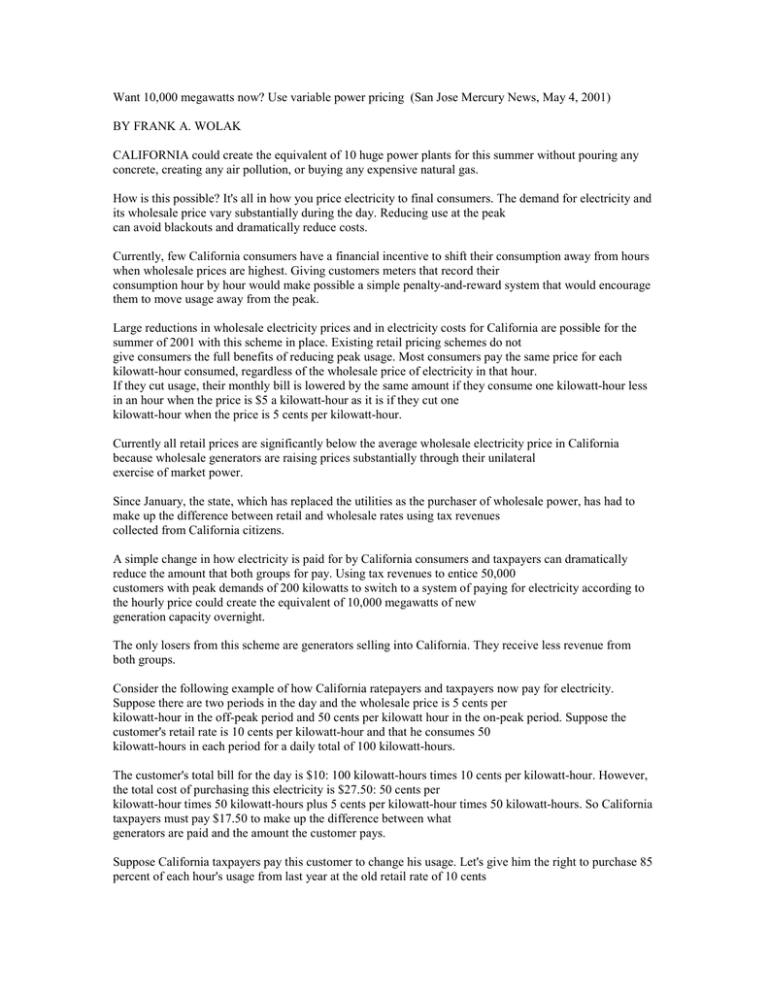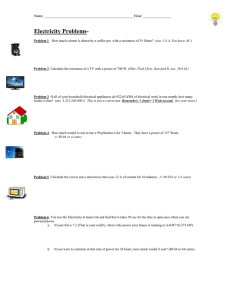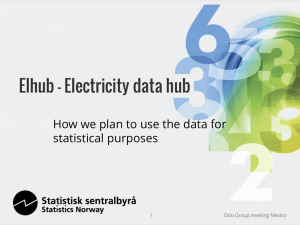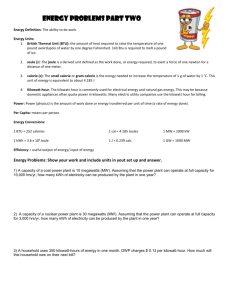Use variable power pricing
advertisement

Want 10,000 megawatts now? Use variable power pricing (San Jose Mercury News, May 4, 2001) BY FRANK A. WOLAK CALIFORNIA could create the equivalent of 10 huge power plants for this summer without pouring any concrete, creating any air pollution, or buying any expensive natural gas. How is this possible? It's all in how you price electricity to final consumers. The demand for electricity and its wholesale price vary substantially during the day. Reducing use at the peak can avoid blackouts and dramatically reduce costs. Currently, few California consumers have a financial incentive to shift their consumption away from hours when wholesale prices are highest. Giving customers meters that record their consumption hour by hour would make possible a simple penalty-and-reward system that would encourage them to move usage away from the peak. Large reductions in wholesale electricity prices and in electricity costs for California are possible for the summer of 2001 with this scheme in place. Existing retail pricing schemes do not give consumers the full benefits of reducing peak usage. Most consumers pay the same price for each kilowatt-hour consumed, regardless of the wholesale price of electricity in that hour. If they cut usage, their monthly bill is lowered by the same amount if they consume one kilowatt-hour less in an hour when the price is $5 a kilowatt-hour as it is if they cut one kilowatt-hour when the price is 5 cents per kilowatt-hour. Currently all retail prices are significantly below the average wholesale electricity price in California because wholesale generators are raising prices substantially through their unilateral exercise of market power. Since January, the state, which has replaced the utilities as the purchaser of wholesale power, has had to make up the difference between retail and wholesale rates using tax revenues collected from California citizens. A simple change in how electricity is paid for by California consumers and taxpayers can dramatically reduce the amount that both groups for pay. Using tax revenues to entice 50,000 customers with peak demands of 200 kilowatts to switch to a system of paying for electricity according to the hourly price could create the equivalent of 10,000 megawatts of new generation capacity overnight. The only losers from this scheme are generators selling into California. They receive less revenue from both groups. Consider the following example of how California ratepayers and taxpayers now pay for electricity. Suppose there are two periods in the day and the wholesale price is 5 cents per kilowatt-hour in the off-peak period and 50 cents per kilowatt hour in the on-peak period. Suppose the customer's retail rate is 10 cents per kilowatt-hour and that he consumes 50 kilowatt-hours in each period for a daily total of 100 kilowatt-hours. The customer's total bill for the day is $10: 100 kilowatt-hours times 10 cents per kilowatt-hour. However, the total cost of purchasing this electricity is $27.50: 50 cents per kilowatt-hour times 50 kilowatt-hours plus 5 cents per kilowatt-hour times 50 kilowatt-hours. So California taxpayers must pay $17.50 to make up the difference between what generators are paid and the amount the customer pays. Suppose California taxpayers pay this customer to change his usage. Let's give him the right to purchase 85 percent of each hour's usage from last year at the old retail rate of 10 cents per kilowatt-hour. Any purchases beyond that level in each hour would be paid for at the prevailing wholesale price for that hour and any consumption below that hourly level would be rewarded with a rebate from the state at the hourly wholesale price. In terms of our previous example, the consumer could buy 42.5 kilowatt-hours in each hour at 10 cents per kilowatt-hour. Suppose the consumer purchased 100 kilowatt-hours as before, but shifted his use to 41 kilowatt-hours in the high-priced period and 59 kilowatt-hours in the lowpriced period. His total bill would be $8.58. It's 85 kilowatt-hours at 10 cents for $8.50; 16.5 kilowatt-hours (the amount over the 42.5 limit) at the off-peak price of 5 cents, for 83 cents; then a rebate from the state of 75 cents, for using 1.5 kilowatt-hour less than the limit when the price is 50 cents per kilowatt-hour. The total cost of this electricity to the state is $23.45. Taxpayers now have to pay $14.87 to make up the difference. Both the customer and taxpayers benefit. Taxpayers pay $2.63 less. The customer pays $1.42 less. If the consumer had continued to purchase 50 kilowatt-hours in each period, his bill would have increased to $12.63. Under SB 5, recently signed by Gov. Gray Davis, all customers with peak demands above 200 kilowatts will have hourly meters before the summer of 2001. Customers whose electricity consumption during 2000 was not measured on an hourly basis can be included in this program by assigning them a representative hourly usage pattern consistent with their monthly consumption. If California is to survive the summer of 2001 without many hours of rolling blackouts, this pricing program must be mandatory for all customers with peak demands above 200 kilowatts. This scheme does not require consuming less electricity on a monthly basis to realize bill reductions and state tax revenue savings. It simply requires shifting time of use. To obtain the greatest benefit from this program, hourly meters should be installed for all customers, including residential customers, as soon as possible. If all California consumers have the ability to benefit from shifting their electricity consumption away from high price hours, this will significantly reduce the ability of generation unit owners to force the state to pay excessive prices in California's wholesale electricity market. Frank A. Wolak is a professor of economics at Stanford University and chairman of the Market Surveillance Committee for the agency that operates California's electricity transmission system.



